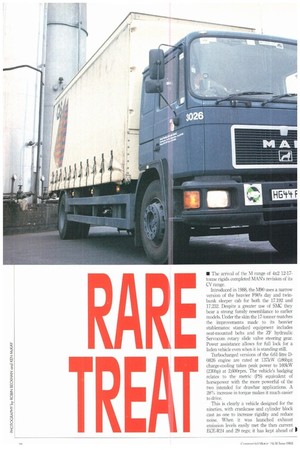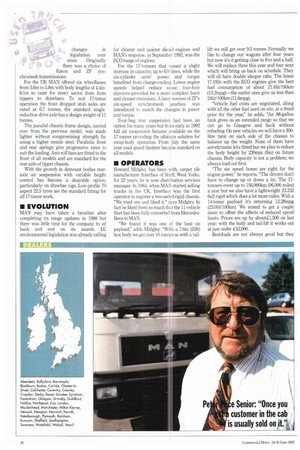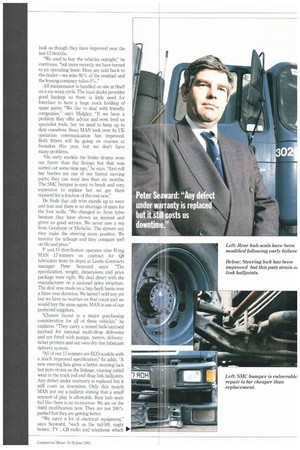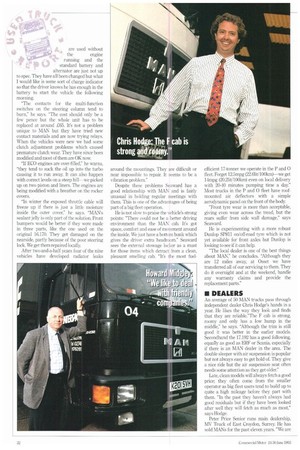W EA
Page 30

Page 32

Page 33

Page 34

Page 35

If you've noticed an error in this article please click here to report it so we can fix it.
• The arrival of the M range of 4x2 12-17tonne rigids completed MAN's revision of its CV range.
Introduced in 1988, the M90 uses a narrow version of the heavier F90's day and twinbunk sleeper cab for both the 17.192 and 17.232. Despite a greater use of SMC they bear a strong family resemblance to earlier models. Under the skin the 17-tonner matches the improvements made to its heavier stablemates: standard equipment includes seat-mounted belts and the ZF hydraulic Servocom rotary slide valve steering gear. Power assistance allows for full lock for a laden vehicle even when it is standing still.
Turbocharged versions of the 6.611itre D0826 engine are rated at 137kW (186hp); charge-cooling takes peak power to 169kW (230hp) at 2,600rpm. The vehicle's badging relates to the metric (PS) equivalent of horsepower with the more powerful of the two intended for drawbar applications. A 28% increase in torque makes it much easier to drive.
This is clearly a vehicle designed for the nineties, with crankcase and cylinder block cast as one to increase rigidity and reduce noise. When it was launched exhaust emission levels easily met the then current ECE-R24 and 29 regs; it has kept ahead of 0 changes in '%aifr*gl*Ilegislation ever since. Originally since. Originally there was a choice of Eaton and ZF synchromesh transmissions.
For the UK MAN offered six wheelbases from 3.6m to 5.8m with body lengths of 4.4m8.1m to cater for every sector from from tippers to drawbars. To suit 17-tonne operation the front dropped stub axles are rated at 6.7 tonnes; the standard singlereduction drive axle has a design weight of 11 tonnes.
The parallel chassis frame design, carried over from the previous model, was made lighter without compromising strength by using a higher tensile steel. Parabolic front and rear springs give progressive rates to suit the loading. Anti-roll bars are fitted to the front of all models and are standard for the rear axle of tipper chassis.
With the growth in demount bodies rearaxle air suspension with variable height control has become a desirable option, particularly on drawbar rigs. Low-profile 70 aspect 22.5 tyres are the standard fitting for al117-tonne work.
• EVOLUTION
MAN may have taken a breather after completing its range updates in 1988 but there was little time for the company to sit back and rest on its laurels. EC environmental legislation was already calling for cleaner and quieter diesel engines and MAN's response, in September 1992, was the ECO range of engines.
For the 17-tonners that meant a slight increase in capacity, up to 6.9 litres, while the six-cylinder units' power and torque benefited from charge-cooling. Lower engine speeds helped reduce noise; four-hole injectors provided for a more complete burn and cleaner emissions. A later version of ZF's six-speed synchromesh gearbox was introduced to match the changes in power and torque.
Four-bag rear suspension had been an option for many years but from early in 1992 full air suspension became available on the 17-tonner providing the ultimate solution for swap-body operation. From July the same year road speed limiters became standard on all models.
• OPERATORS
Howard Midgley has been with, carpet tile manufacturer Interface of Shelf, West Yorks, for 22 years; he is now distribution services manager. In 1984, when MAN started selling trucks in the UK, Interface was the first operator to register a two-axled rigid chassis. "We tried one and liked it," says Midgley. In fact he liked them so much that the 11-vehicle fleet has been fully converted from MercedesBenz to MAN.
"We found it was one of the best on payload," adds Midgley. "With a 7.6m (25ft) box body we get over 10 tonnes so with a tail lift we still get over 9.5 tonnes. Normally we like to change our wagons after four years but now it's it getting close to five and a halt We will replace three this year and four next which will bring us back on schedule. They will all have double sleeper cabs. The latest 17.192s with the ECO engines give the best fuel consumption of about 21.41it/100km (13.2mpg)—the earlier ones give us less than 241it1100km (11.6mpg).
"Vehicle fuel costs are negotiated, along with all the other fuel used on site, at a fixed price for the year," he adds. "An 88-gallon tank gives us an extended range so that we can go to Glasgow and back without refueling. On new vehicles we will have a 300litre tank on each side of the chassis to balance up the weight. None of them have aerodynamic kits fitted but we plan to reduce the body height by 230nim (Yin) on future chassis. Body capacity is not a problem; we always load out first.
"The six speed boxes are right for the engine power," he reports. "The drivers don't have to change up or down a lot. The 17tanners cover up to 156,000km (96,000 miles) a year but we also have a lightweight 23.232 6x2 rigid which does a lot more miles. With a 14-tonne payload it's returning 12.28mpg (23.01W100km). We intend to get a couple more to offset the affects of reduced speed limits. Prices are up by about£1,500 on last year: with the body and tail-lift it works out at just under £42,000.
Residuals are not always good but they look as though they have improved over the last 12 months.
"We used to buy the vehicles outright," he continues, "but more recently we have turned to an operating lease. Most are sold back to the dealer—we take 95% of the residual and the leasing company takes 5%."
All maintenance is handled on site at Shelf on a six-week cycle. The local dealer provides good backup so there is little need for Interface to have a large stock holding of spare parts: "We. like to deal with friendly companies," says Midgley. "If we have a problem they offer advice and even lend us specialist tools, but we need to keep up to date ourselves. Since MAN took over its UK operation communication has improved. Both fitters will be going on courses at Swindon this year, but we don't have many problems.
"On early models the brake drums wore out faster than the linings but that was sorted out some time ago," he says. "Anti-roll bar bushes are one of our fastest moving parts; they can wear less than six months. The SMC bumper is easy to break and very expensive to replace but we get them repaired for a fraction of the cost new."
He finds that cab trim stands up to wear and tear and there is no shortage of mats for the foot wells. "We changed to Avon tyres because they have shown an interest and given us good service. We never saw a rep from Goodyear or Michelin. The drivers say they make the steering more positive. We monitor the mileage and they compare well on life and price."
P and 0 distribution operates nine H-reg MAN 17-tonners on contract for Q8 lubricants from its depot at Leeds. Contracts manager Peter Seaward says: "The specification, weight, dimensions and price package were right. We deal direct with the manufacturer on a national price structure. The deal was made on a buy-back basis over a three-year duration. We haven't sold any yet but we have no worries on that count and we would buy the same again. MAN is one of our preferred suppliers.
"Chassis layout is a major purchasing consideration for all of these vehicles," he explains. "They carry a mixed bulk/unitised payload for national multi-drop deliveries and are fitted with pumps, meters, delivery ticket printers and our own dry-line lubricant delivery system.
"All of our 17-tonners are ECO models with a much improved specification," he adds. "A new steering box gives a better steering lock but puts strain on the linkage, causing initial wear in the track rod and drag link balljoints. Any defect under warranty is replaced but it still costs us downtime. Only this month MAN put out a bulletin stating that a small amount of play is allowable. Rear hub seals fail like there is no to-morrow. We are on the third modification now. They are not 100% perfect but they are getting better.
"We carry a lot of electrical equipment," says Seaward, 'such as the tail-lift, night heater, TV , CB radio and telephone which
04,4 are used without
the engine 4Z‘ running and the standard battery and alternator are just not up to spec. They have all been changed but what I would like is some sort of charge indicator so that the driver knows he has enough in the battery to start the vehicle the following morning The contacts for the multi-function switches on the steering column tend to burn," he says. "The cost should only be a few pence but the whole unit has to be replaced at around £65. It's not a problem unique to MAN but they have tried new contact materials and are now trying relays. When the vehicles were new we had some clutch adjustment problems which caused premature clutch wear. They have since been modified and most of them are OK now.
if ECO engines are over-filled," he warns, "they tend to suck the oil up into the turbo (musing it to run away It can also happen with correct levels on a steep hill—we picked up on two piston and liners. The engines are being modified with a breather on the rocker covers.
In winter the exposed throttle cable will freeze up if there is just a little moisture inside the outer cover," he says. "IvIAN's sealant jelly is only part of the solution. Front bumpers would be better if they were made in three parts, like the one used on the original 16.170. They get damaged on the nearside, partly because of the poor steering lock. We get them repaired locally.
After two-and-a-half years four of the nine vehicles have developed radiator leaks around the mountings. They are difficult or near impossible to repair. It seems to be a vibration problem."
Despite these problems Seaward has a good relationship with MAN and is fairly unusual in holding regular meetings with them. This is one of the advantages of being part of a big fleet operation.
He is not slow to praise the vehicle's strong points: "There could not be a better driving environment than the MAN cab. It's got space, comfort and ease of movement around the inside. We just have a bottom bunk which gives the driver extra headroom." Seaward sees the external stowage lock-er as a must for those items which detract from a clean, pleasant smelling cab. "It's rl'e most fuel
efficient 17-tonner we operate in the P and 0 fleet. Forget 12.5mpg (22.61it/100km)—we get 14mpg (20.214/100km) even on local delivery with 20-90 minutes pumping time a day" Most trucks in the P and 0 fleet have roofmounted air deflectors with a simple aerodynamic panel on the front of the body "Front tyre wear is more than acceptable, giving even wear across the tread, but the rears suffer from side wall damage," says Seaward.
He is experimenting with a more robust Dunlop SP811 on/off-road tyre which is not yet available for front axles but Dunlop is looking to see if it can help.
"The local dealer is one of the best things about MAN," he concludes. "Although they are 12 miles away, at Osset we have transferred all of our servicing to them. They do it overnight and at the weekend, handle any warranty claims and provide the replacement parts."
II DEALERS
An average of 50 MAN trucks pass through independent dealer Chris Hodges hands in a year. Ile likes the way they look and finds that they are reliable.''The F cab is strong, roomy and only has a low hump in the middle," he says. "Although the trim is still good it was better in the earlier models, Secondhand the 17.192 has a good following, equally as good as EU or Smnia, especially if there is an MAN dealer in the area. The double sleeper with air suspension is popular but not always easy to get hold of. They give a nice ride but the air suspension seat often needs some attention as they get older."
Late, clean models will always fetch a good price; they often come from the smaller operator as big fleet users tend to build up to quite a high mileage before they part with them. "In the past they haven't always had good residuals but if they have been looked after well they will fetch as much as most," says Hodge.
Peter Price Senior runs main dealership, MV Truck of East Croydon, Surrey He has sold MANs for the past eleven years. ''We are a VW/MAN dealer and normally have about 15 used trucks in stock," he says. "Many operators who have changed their vehicle after two or three years in the past have been holding on to them longer; good examples are like gold dust. Supply started to dry up about 18 months ago and stocks have got really low over the past seven months. In that time prices have increased.
"It's got to the point where there are very few young tucks in any weight range becoming available and customers interested in that segment of the market are having to buy new again," he adds. "It has to be said that the 17-tonner is not our biggest seller, but it is a superb vehicle and underrated by most operators. Once you get a customer in the cab he is usually sold on it. It's very spacious and quiet and its high power-toweight ratio does not mean more fuel either. We have a sales team who deal only with used trucks and if we haven't got a vehicle in stock we do our best to find one at the right price. With availability curtailed age is not a problem. We will consider anything if it is in good condition."
• SUMMARY
The price of used vehicles inevitably depends to a large extent n demand, availability and condition.
According to Glass's Guide depreciation for a three-to-five-year-old 17.192 shows some advantage over the Leyland Daf 17.18
Freighter but is not as good as the M Benz 1717. The less powerful of MI tonners is far from under-powered operation and our operators confirm well enough even with only six gear fuel returns were better than we achi test and that is without the advantag spoilers. It is not without its fat improved communications wit' manufacturer ensure that they ar attended to.
From a driver's point of view th( has one of the best cabs of any 17-tc the market. It's quiet, roomy and th4 good. If the steering lock can be ir there's little left to complain about. 0 by Bill Brock
















































































